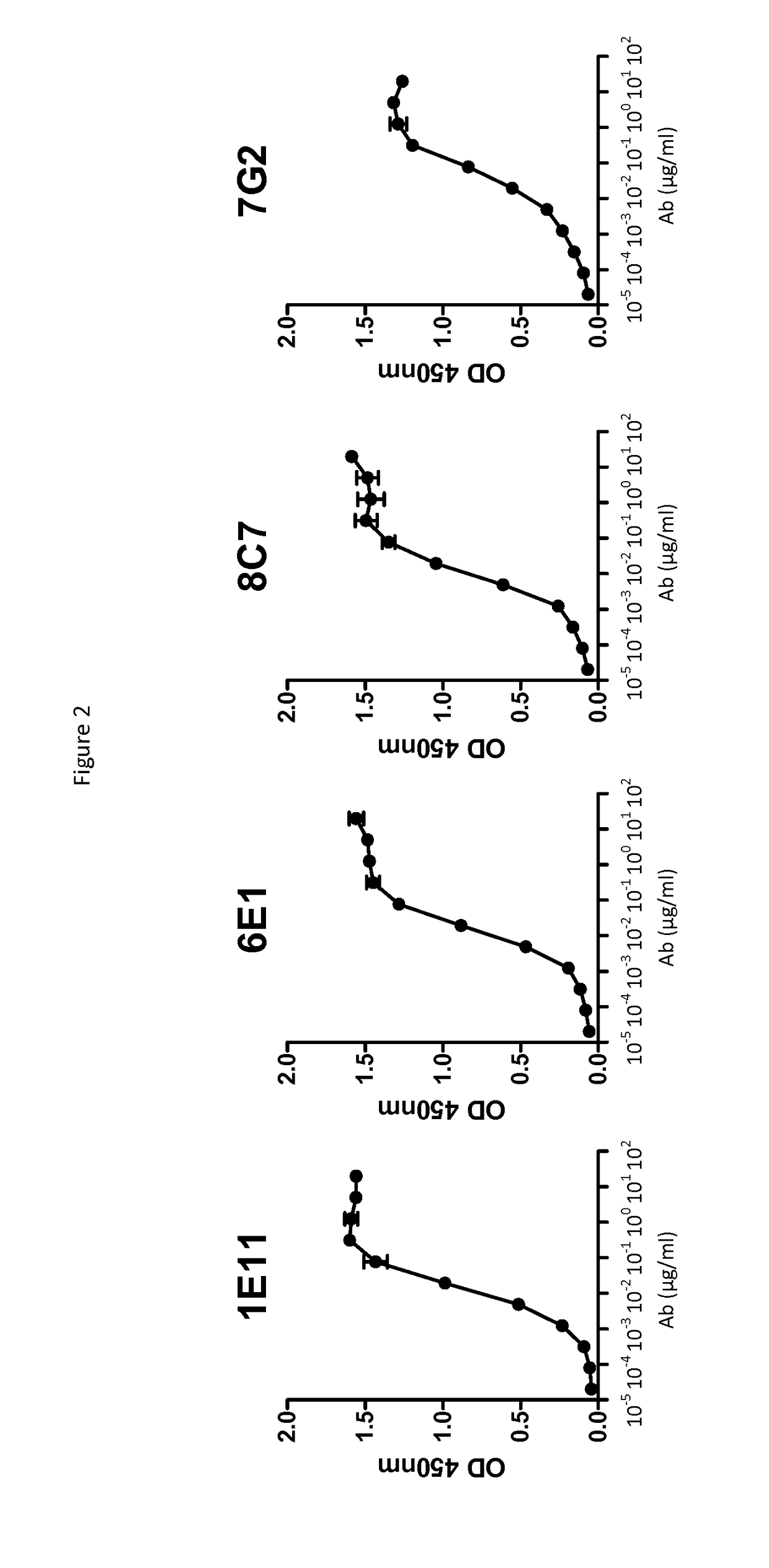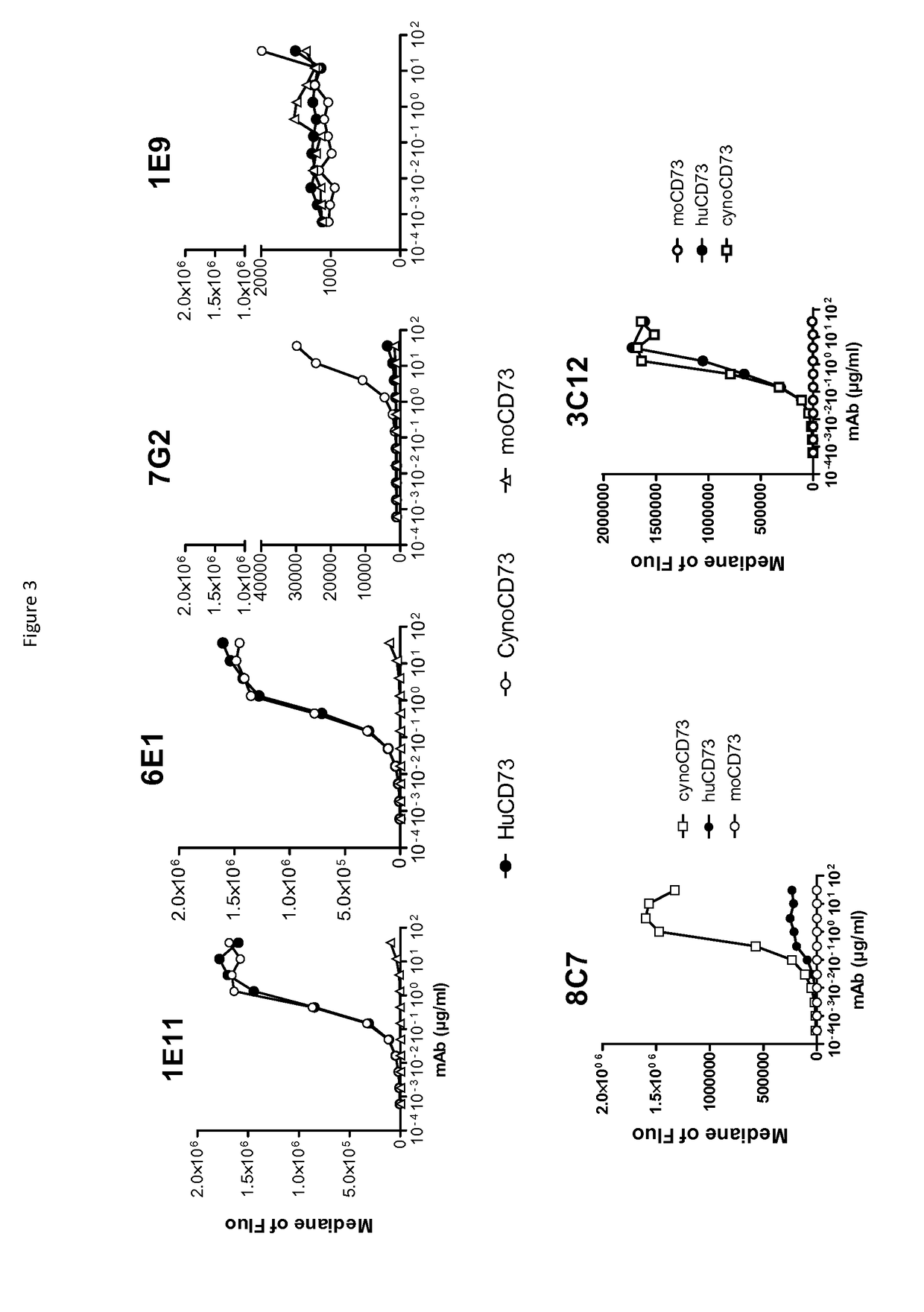Cd73 blockade
a cd73 and blockade technology, applied in the field of cd73 blockade, can solve the problems of inability to fully distinguish cd73 blockade effect from fc-mediated effect, inability to fully elucidate the activity required of an agent to target cd73 in vivo, and difficulty in determining the mode of action of antibodies, so as to inhibit the cd73-mediated catabolism of amp, increase the concentration of adp and atp
- Summary
- Abstract
- Description
- Claims
- Application Information
AI Technical Summary
Benefits of technology
Problems solved by technology
Method used
Image
Examples
example 1
n of New Anti-huCD73 Antibodies
[0272]To obtain anti-human CD73 antibodies, Balb / c mice were immunized with a recombinant human CD73-His extracellular domain recombinant protein (cloned and produced at Innate Pharma as described below). Mice received one primo-immunization with an emulsion of 50 μg CD73 protein and Complete Freund Adjuvant, intraperitoneally, a 2nd immunization with an emulsion of 50 μg CD73 protein and Incomplete Freund Adjuvant, intraperitoneally, and finally a boost with 10 μg CD73 protein, intravenously. Immune spleen cells were fused 3 days after the boost with X63.Ag8.653 immortalized B cells, and cultured in the presence of irradiated spleen cells. Hydridomas were plated in semi-solid methylcellulose-containing medium and growing clones were picked using a clonepix 2 apparatus (Molecular Devices).
[0273]Primary screen: Supernatant (SN) of growing clones were tested in a primary screen by flow cytometry using parental and huCD73-, cynoCD73- or moCD73-expressing ...
example 2
n of Soluble CD73 Blockade
[0280]The ability of anti-CD73 antibodies to block enzymatic activity of CD73 was evaluated as described in Sachsenmeier et al. (J Biomol Screening, 2012). Briefly, 500 ng / ml of recombinant human CD73-his were incubated in white 96W flat bottom microplates in presence of dose-range of anti-CD73 or isotype control Abs. Plates were incubated for 1 h at 37° C. 12.5 μM ATP and 125 μM AMP were added to each well and plates are incubated at 37° C. for 30 supplemental minutes. Luciferase / luciferin-containing Cell Titer Glo (Promega) is added into wells, plates were incubated for 5 minutes at RT in the dark and emitted light is measured using an Enspire apparatus (Perkin Elmer).
[0281]Excess of AMP is known to block ATP-dependent luciferase activity. Addition of CD73 that cleaves AMP into adenosine+inorganic phosphate restores luciferase activity and light emission. Thus, antibodies that block enzymatic activity of CD73 will diminish light emission.
[0282]The percent...
example 3
ion on Rec CD73 Protein by ELISA
[0291]Antibodies that functionally blocked soluble recombinant CD73 were more fully characterized for binding to soluble recombinant human CD73.
[0292]5 μg / ml of recombinant human CD73 protein (IPH, isoform E6) was coated on MaxiSorp ELISA plates (Nunc) in PBS, overnight at 4° C. Plates were washed 5 times in washing buffer (PBS, 0.05% Tween20) and unspecific sites were saturated by adding 200 μl / w TBS starting block buffer (Thermo Ficher). Dose-range of anti-CD73 antibodies were incubated for 2 h at 37° C. Plates were washed 5 times in washing buffer and HRP-coupled goat anti-human or goat anti-mouse IgG Fc fragment secondary antibody (Bethyl, 1 / 50000) was added for 1 hr at RT to detect bound anti-CD73 antibodies. Plates were washed 5 times in washing buffer and bound secondary antibody is revealed by adding TMB (HRP substrate) and incubating plates for 5 to 10 min at RT in the dark. The enzymatic reaction was stopped by adding HCl 1M and O.D. was mea...
PUM
| Property | Measurement | Unit |
|---|---|---|
| concentration | aaaaa | aaaaa |
| concentration | aaaaa | aaaaa |
| concentration | aaaaa | aaaaa |
Abstract
Description
Claims
Application Information
 Login to View More
Login to View More - R&D
- Intellectual Property
- Life Sciences
- Materials
- Tech Scout
- Unparalleled Data Quality
- Higher Quality Content
- 60% Fewer Hallucinations
Browse by: Latest US Patents, China's latest patents, Technical Efficacy Thesaurus, Application Domain, Technology Topic, Popular Technical Reports.
© 2025 PatSnap. All rights reserved.Legal|Privacy policy|Modern Slavery Act Transparency Statement|Sitemap|About US| Contact US: help@patsnap.com



